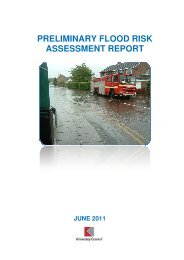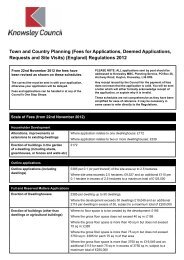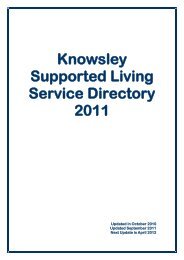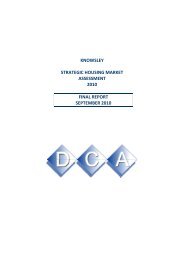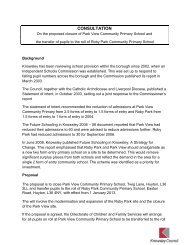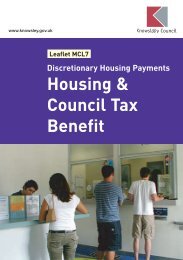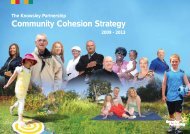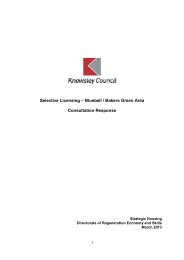Knowsley Replacement Unitary Development Plan - Knowsley Council
Knowsley Replacement Unitary Development Plan - Knowsley Council
Knowsley Replacement Unitary Development Plan - Knowsley Council
You also want an ePaper? Increase the reach of your titles
YUMPU automatically turns print PDFs into web optimized ePapers that Google loves.
TRANSPORT<br />
TRANSPORT<br />
8.27<br />
As a guideline, all proposals for major traffic<br />
generating proposals as defined above should be on<br />
sites that are within 400 metres safe and convenient<br />
walking distance of a bus stop, and/or within 800<br />
metres of a stop on the proposed Merseytram<br />
network or a railway station. This distance will be<br />
influenced by factors such as topography and the<br />
need to get across busy main roads.<br />
8.28<br />
POLICY LINKS<br />
Policy PA1<br />
“<strong>Plan</strong>ning Agreements”<br />
Policy T8<br />
“Transport Assessments”<br />
Policy T9<br />
“Travel <strong>Plan</strong>s”<br />
Policy T10<br />
“Access for the Less Mobile”<br />
EXPLANATION T6<br />
8.30<br />
Policy T6 aims to ensure that there is a good choice<br />
of mode of travel for all development proposals, with<br />
an emphasis on walking, cycling and public transport.<br />
New developments will be expected to include<br />
provision for walking and cycling which links well<br />
with the wider pedestrian and cycle networks and<br />
which also links well with public transport facilities.<br />
These links should be attractively designed as an<br />
integral part of the development.<br />
8.33<br />
New developments should be well served by public<br />
transport. Where necessary additional bus stops or<br />
other facilities will be provided within the site or the<br />
immediate locality. Where appropriate, obligations<br />
will be negotiated which require developers to make<br />
a contribution (for a specified period of up to a<br />
maximum of five years) to the provision of new<br />
public transport services that are deemed<br />
necessary in order to ensure that the development<br />
is adequately served.<br />
It is also important to ensure that major<br />
developments are well located in relation the rail<br />
network and the Strategic Road Network to avoid<br />
problems of congestion and of large vehicles (and<br />
other traffic) using unsuitable local roads. Where a<br />
proposal would significantly increase the volume of<br />
traffic on the trunk road network, the <strong>Council</strong> will<br />
consult the Highways Agency prior to making a<br />
decision on the planning application. A Memorandum<br />
of Understanding with the Highways Agency provides<br />
a framework for considering major development<br />
proposals in a way which would not prejudice the<br />
implementation of regeneration programmes.<br />
8.29<br />
Where development sites fail to meet these criteria,<br />
the <strong>Council</strong> will discuss the issue with its transport<br />
planning partners. Where satisfactory provision<br />
would not otherwise occur, the developer will be<br />
asked to enter into a planning agreement (see<br />
glossary) to cover or contribute towards the cost of<br />
additional public transport provision, or rail freight or<br />
highway infrastructure which is needed to serve the<br />
development. The proposed Supplementary <strong>Plan</strong>ning<br />
Document (SPD) on Transport issues (see paragraph<br />
8.1 above) will explain the requirements of this policy<br />
and give greater definition to the land use categories<br />
in table 8.1.<br />
POLICY T6:<br />
ENSURING CHOICE OF TRAVEL TO SERVE<br />
NEW DEVELOPMENTS<br />
1. Proposals for new development should provide<br />
or be served by a good choice of modes of<br />
travel which is appropriate to the scale and<br />
nature of the development, as follows:<br />
a) Well lit, safe, convenient and clearly<br />
sign-posted footways and cycle routes both<br />
within the site and linking to the<br />
surrounding area and to public transport<br />
facilities;<br />
b) Cycle parking facilities in accordance with<br />
the <strong>Council</strong>’s minimum standards;<br />
c) Car parking facilities which do not exceed<br />
the <strong>Council</strong>’s maximum standards;<br />
d) Parking facilities for the less mobile,<br />
delivery and other service vehicles within<br />
the site in accordance with the <strong>Council</strong>’s<br />
minimum standards;<br />
e) Safe and convenient vehicular access to<br />
and from the highway and within the<br />
site; and<br />
f) Good provision of public transport to the<br />
site. In the case of major developments,<br />
and any other developments likely to<br />
generate a significant amount of travel<br />
demand, the provision of additional public<br />
transport facilities such as bus stops, bus<br />
layover bays, taxi bays or other facilities<br />
may be required within or adjacent to<br />
the site.<br />
2. Exceptions to the above will be considered in<br />
the case of minor extensions, alterations or<br />
other developments, which will not materially<br />
increase the amount of traffic visiting the site.<br />
8.31<br />
To promote community and road safety, no<br />
developments will be permitted which would cause a<br />
hazard as a result, for example, of the design of the<br />
highway access or internal circulation system.<br />
Car parks, cycle parking facilities and footpaths<br />
should always be well surfaced and lit, and subject to<br />
natural surveillance from occupied buildings.<br />
Conflict between vehicle and pedestrian routes<br />
should be avoided or actively managed through the<br />
use of designs which slow traffic in areas of shared<br />
use. In some parts of the Borough, on-street parking<br />
causes inconvenience and hazard and new<br />
developments will not be permitted which would<br />
cause or exacerbate such hazards.<br />
8.32<br />
Car parking standards will be set as a maximum<br />
(in order to encourage the shift towards more<br />
sustainable forms of travel) and will be set down in<br />
the proposed Supplementary <strong>Plan</strong>ning Document<br />
(SPD) covering transport issues, along with cycle<br />
parking and standards for the provision of parking<br />
spaces for the less mobile. In Huyton, Kirkby and<br />
Prescot town centres, together with district and<br />
local centres, a smaller number of parking spaces<br />
may be considered appropriate, provided the<br />
development would not cause parking problems in<br />
the centre as a whole.<br />
8.34<br />
In implementing the policy, the <strong>Council</strong> will take<br />
account of the scale and nature of the development.<br />
For example, minor extensions or alterations to<br />
properties may not have any material impact on<br />
travel patterns in the area. In these circumstances, it<br />
would not be reasonable to require the developer to<br />
provide additional facilities. The proposed Transport<br />
Supplementary <strong>Plan</strong>ning Document (SPD) will explain<br />
in detail to which forms of development, and in what<br />
circumstances, the policy will be applied.<br />
POLICY LINKS<br />
Policy DQ1<br />
“Design Quality in New <strong>Development</strong>”<br />
Policy DQ2<br />
“Security in the Built Environment”<br />
Policy T8<br />
“Transport Assessments”<br />
Policy T9<br />
“Travel <strong>Plan</strong>s”<br />
Policy T10<br />
“Access for the Less Mobile”<br />
88<br />
KNOWSLEY REPLACEMENT UNITARY DEVELOPMENT PLAN: Adopted June 2006<br />
KNOWSLEY REPLACEMENT UNITARY DEVELOPMENT PLAN: Adopted June 2006<br />
89



